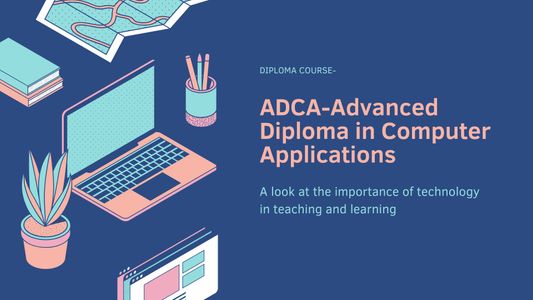ADCA for IT Beginners: A Step-by-Step Guide
 Vanshika Sharma
16 Jan, 2025
10 mins read
1357
Vanshika Sharma
16 Jan, 2025
10 mins read
1357

In the digital age, computer skills are essential for both professional and personal growth. Many beginners interested in learning computer applications often ask, “Where do I start?” One of the best answers is ADCA, which stands for Advanced Diploma in Computer Applications. The course provides a comprehensive introduction to computers, making it ideal for those with little or no prior experience in IT.
This article is a step-by-step guide to understanding ADCA, its benefits, syllabus, and how it helps beginners kick-start their IT journey. Let’s dive in and explore everything you need to know about this course.
What Is ADCA?
The ADCA full form is Advanced Diploma in Computer Applications. It is a short-term diploma course designed to provide foundational and advanced knowledge of computer applications. ADCA is perfect for beginners as it covers topics ranging from computer basics to advanced tools like programming, database management, and web development.
The course typically lasts 6 months to 1 year and is available both online and offline. Its job-oriented curriculum makes it a preferred choice among students looking to enter the IT field.
Why Is ADCA Ideal for Beginners?
If you are new to the world of computers, ADCA is a great starting point. Here’s why:
1. No Prior Knowledge Required
ADCA is designed for beginners, so you don’t need any previous experience in computers. The course starts with basic topics like how to use a computer, operate Windows, and work with Microsoft Office tools.
2. Comprehensive Syllabus
ADCA covers a wide range of topics, from computer fundamentals to advanced programming and web development. This ensures that beginners gain well-rounded knowledge and skills.
3. Affordable and Accessible
The course is budget-friendly, making it accessible to students from all backgrounds. Many institutes also offer flexible learning options like weekend classes and online courses.
4. Job-Ready Skills
ADCA focuses on practical learning, equipping students with job-ready skills in areas like data entry, office management, and web design.
Step-by-Step Guide to ADCA for Beginners
Here’s a detailed step-by-step guide for beginners interested in pursuing ADCA:
Step 1: Understand the Eligibility Criteria
To enroll in ADCA, you need to have completed at least your 10th or 12th grade. Some institutes may prefer candidates with basic computer knowledge, but it’s not mandatory.
Step 2: Choose the Right Institute
Look for a reputed institute that offers a well-structured ADCA program. Consider factors like:
- Faculty expertise
- Course curriculum
- Placement support
- Mode of learning (online/offline)
Step 3: Enroll in the Course
Once you’ve selected an institute, complete the admission process by filling out the application form, submitting the required documents, and paying the fees.
Step 4: Learn the Basics
The first phase of the ADCA course focuses on computer basics, including:
- Understanding hardware and software
- Operating systems like Windows
- Introduction to the internet and email
Step 5: Master Office Tools
The next step involves learning office automation tools such as:
- MS Word for creating documents
- MS Excel for spreadsheets
- MS PowerPoint for presentations
These tools are essential for any office job and are covered in detail during the course.
Step 6: Explore Programming Languages
As you progress, you’ll be introduced to programming languages like C, C++, and Java. These languages form the foundation of software development and are taught in a beginner-friendly manner.
Step 7: Dive into Web Development
Learn how to design and develop websites using HTML, CSS, and JavaScript. This section of the course is ideal for students interested in becoming web developers.
Step 8: Understand Database Management
Gain knowledge of database management systems (DBMS) and learn how to handle data using SQL. This skill is valuable for jobs involving data entry and analysis.
Step 9: Practical Projects
Most ADCA courses include practical assignments and projects, allowing students to apply their knowledge in real-world scenarios.
Step 10: Certification and Placement
After completing the course, you’ll receive an ADCA certification. Many institutes also provide placement assistance to help you secure a job.
What Does the ADCA Syllabus Include?
The syllabus of ADCA varies by institute but typically includes the following:
1. Computer Basics
- Introduction to computers
- Operating systems (Windows and Linux)
2. Office Automation Tools
- MS Word, MS Excel, MS PowerPoint
- Tally for accounting
3. Programming Languages
- C, C++, Java
4. Web Development
- HTML, CSS, JavaScript
5. Database Management
- SQL and data handling
6. Graphic Design (Optional)
- Basics of Photoshop and CorelDRAW
Benefits of ADCA for Beginners
- Builds a Strong Foundation: ADCA starts with basics, ensuring that even beginners can follow along and learn effectively.
- Career-Oriented: The course equips you with practical skills that are directly applicable to jobs in IT and other fields.
- Short Duration: The course duration is short, allowing you to gain skills and enter the workforce quickly.
- Wide Career Opportunities: ADCA graduates can pursue roles such as data entry operator, web designer, office assistant, and more.
Challenges for Beginners in ADCA
While ADCA is beginner-friendly, some students may face challenges such as:
- Understanding programming languages, which can be complex initially.
- Balancing study time with other commitments if enrolled in an online course.
- Choosing the right institute that offers quality education and practical training.
To overcome these challenges, stay consistent in your studies, seek help from faculty, and practice regularly.
Conclusion
The ADCA full form, Advanced Diploma in Computer Applications, is one of the best courses for beginners looking to build IT skills. With its comprehensive syllabus, practical training, and career-oriented approach, ADCA prepares students for various roles in IT and beyond.
By following this step-by-step guide, you can make the most of your ADCA journey and set yourself on the path to success. Whether you’re a student, a working professional, or someone looking to start a new career, ADCA is a great choice to gain valuable skills in a short time.
FAQs
1. What is the duration of the ADCA course?
The ADCA course typically lasts 6 months to 1 year, depending on the institute.
2. Can beginners enroll in ADCA?
Yes, ADCA is designed for beginners and covers both basic and advanced topics in computer applications.
3. What jobs can I get after completing ADCA?
ADCA graduates can work as data entry operators, web designers, IT support staff, or office assistants.
4. Is ADCA available online?
Yes, many institutes offer ADCA courses online, providing flexibility for students and working professionals.
5. What are the fees for the ADCA course?
The fees for ADCA range from ₹5,000 to ₹20,000, depending on the institute and course structure.
Written By:
Vanshika Sharma



Hotels at your convenience
Now choose your stay according to your preference. From finding a place for your dream destination or a mere weekend getaway to business accommodations or brief stay, we have got you covered. Explore hotels as per your mood.





